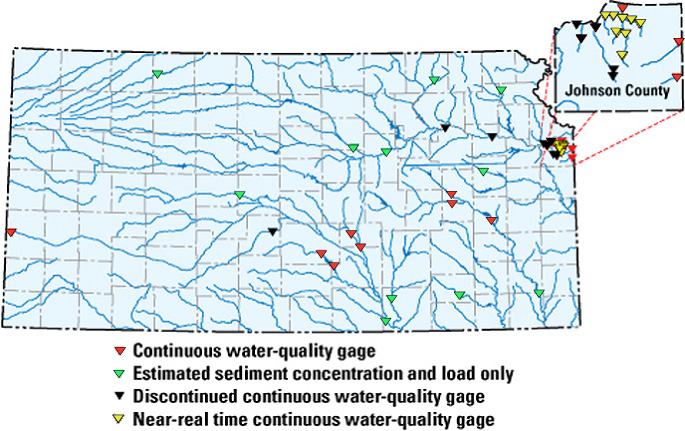Kansas Water Science Center
USGS Water Science Centers are located in each state. 
|
Water Quality
This map shows USGS streamgages (red, green, black and yellow triangles) in Kansas from which estimated concentrations and loads are available. Real-time Water QualityU.S. Geological Survey (USGS) development of a real-time water-quality monitoring system for 13 sites in Kansas began in 1998 in cooperation with the city of Wichita as part of the Equus Beds Groundwater Recharge Demonstration Project. Real-time estimates from the monitoring system eliminates the waiting time inherent in chemical analyses to be reported by a laboratory and provides continuous concentrations and loads. The city of Wichita can then alter treatment of the water to meet the changes in the water quality in the Little Arkansas River and prevent degradation of the Equus Beds aquifer by artificial recharge. Real-time water-quality information in the monitoring system includes hourly measurements of streamflow, specific conductance, pH, water temperature, dissolved oxygen, and turbidity. Because sensor technology currently is not available to directly measure many chemicals of interest in a stream, statistical models are developed to link constituents in laboratory-analyzed samples with the in-stream continuous-sensor measurements. As the hourly sensor measurements are transmitted from the gaging stations to the USGS computers in Lawrence, Kansas, the models are applied and the computed estimates displayed to the web page. The uncertainty of the estimates also is documented so decisions made on the basis of the estimates can be put in proper management perspective.
 Organic Geochemistry Research LaboratoryThe Organic Geochemistry Research Laboratory (OGRL) focuses on two important issues of multidisciplinary research. First, is the fate, transport, and degradation of organic contaminants in the environment with special on nonpoint-source contamination from agricultural chemicals. Second, are in the environment emerging contaminants and how they affect the water. These compounds are combined with analytical methods to determine and link to both geochemical and hydrologic processes. Cyanobacterial (Blue-Green Algal) Blooms: |